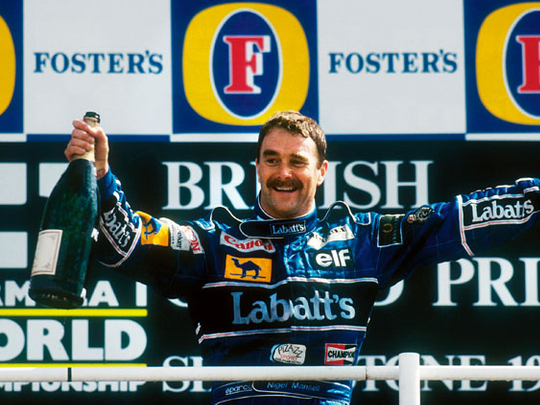
There have been some truly astonishing moments in Formula 1 history. We’ve seen it all from those legendary tussles between Alain Prost and Ayrton Senna (who can forget the race in Japan in 1989 when they collided in the last chicane and both went off the track) to Christian Fittipaldi back flipping his car over the finish line in first place at the 1993 Italian Grand Prix and to Martin Brundle walking away unhurt following a massive crash in Australia three years later. But in my mind, one incident sticks out more than most.
It was way back in 1984 during the Dallas GP when the mustachioed Nigel Mansell crashed into a wall on the last corner of the race. He hopped out of his damaged Lotus 95T and desperately tried to push it over the finish line but collapsed in a heap on the floor due to the extreme heat. I feared the worst thinking he’d died. I guess the eyes can play tricks on you when you are just six or seven years old, as I was at the time.
He’d survived a broken neck during his Formula Ford days so a little hyperthermia wasn’t going to keep him out of action for long. Maybe it was out of sympathy more than anything else but watching him toil with his car was enough to make him my favourite driver.
Drama seemed to follow the Brit on the track — he’d often take on daring overtaking manoeuvres and muscled his cars on circuits all over the world like a man possessed. Taking on the aforementioned greats, Senna and Prost, would require serious skill, grit and determination. Nigel had enough to waste.
Fans loved him for his no-nonsense fighting style and you just knew when he lined up on the grid, the race would be thoroughly exciting. He had a never-say-die attitude, which he demonstrated on his Grand Prix debut.
It was in Austria, 1980, and his Lotus sprung a leak and fuel was entering the cockpit causing him first and second degree burns. But he continued with the race in spite of being in sheer agony and only stopped when his car broke down. With Colin Chapman at the helm, he forged a close relationship with Lotus. But, after Colin’s death in 1982, life with the team became a struggle for the Midlander.
New owner Peter Warr couldn’t stand him citing he had a difficult personality and was rather complex and demanding. But this just added to his persona. He tasted success while with Williams, but having left them for the second time in his glittering career, team boss Frank famously stated that, “We’ll miss him as a driver but not as a bloke.”
Now at Ferrari and during the 1989 Brazil GP, rumours were rife that he’d booked himself an early flight home because he hadn’t expected the unreliable car to finish the race. But he battled the dreadful semi-automatic gearbox and wrestled the car to first place. The tifosi loved his fighting spirit and christened him ‘Il Leone’ (The Lion).
He followed that up with another amazing victory in Hungary, where he battled from 12th and overtook Senna’s McLaren to secure a sensational win. Following his retirement from Formula 1 in 1993, he joined the Newman/Haas Cart IndyCar team, winning the title in his first season, but made a comeback in 1994 with Williams and took his final GP in victory in Adelaide.
He was awarded the title of BBC Sports Personality of the year in 1986 and 1992 having proved he could live with the best of them during arguably the toughest era of Formula 1. In 2005, he was inducted into the International Motorsports Hall of Fame.











